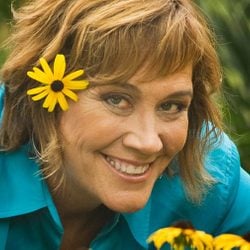Branch out beyond typical conifer trees and shrubs with evergreen perennials that will add year-round color to your yard.

Evergreen Perennials Shine Year-Round

On This Page
Benefits of Evergreen Perennials

The standards for unwavering greenery are often conifers or broadleaf bushes, but there are countless opportunities to get creative with other evergreen plants. Not only do they feature pretty foliage year-round, but many also produce showy blooms or berries, provide winter interest and attract wildlife, says Lorin Nielsen, head horticulturist and senior botanical editor of Epic Gardening in San Diego, California.
“Some evergreens pick up reddish tinges in the fall, have variegated colors or get lighter in color during the peak summer heat,” Lorin says. “The fruit or fallen seeds from the flowers provide food for birds. Low evergreen heath plants from the Ericaceae plant family bloom in the winter or spring, providing some of the first flowers that pollinators rely on for sustenance, and many evergreen, perennial ground covers can shelter insects or small wildlife.”
Early blooming perennials also bridge the gap from winter through to the arrival of the first annual flowers, and some evergreens are edible, Lorin adds. “Creeping rosemary, a common woody ground cover plant, is a staple in my yard. Not only does it produce tiny blue flowers at multiple times of the year, but it also provides me with a never-ending supply of fresh rosemary for cooking,” she says.
When to Plant Evergreen Perennials

Fall is the ideal time for the southern half of the United States to plant evergreen perennials so the plant can stretch out its roots into your soil before winter. Or start from seed indoors in the winter and plant in late winter to early spring, Lorin suggests. In northern regions, plant evergreens in early spring as the weather warms.
“If you have a sudden burst of heat or a snap frost, protect your plant with shade cloth (for heat) or frost blankets (for cold),” she adds. Before investing in an evergreen, check which species will overwinter best in your zone.
Best Evergreen Perennials to Grow
Aureomaculata Leopard Plant
Farfugium japonicum, Zones 7 to 9
A member of the sunflower family, this herbaceous perennial has yellow blooms from summer through fall with 6-to-12-inch-long yellow-spotted dark green leaves on hairy reddish stems.
Lungwort

Pulmonaria, Zones 3 to 8
Speckled silvery green foliage on lungwort adds interest while bees and hummingbirds enjoy the rich blue, purple and white flowers that blossom from salmon pink buds in early spring.
Mediterranean Spurge

Euphorbia characias, Zones 6 to 8
This sculptural plant features blue-green foliage with neon green bracts from February through May. It provides drama against a wall, in a large pot or in the back of your border.
Black Scallop Bugleweed

Ajuga reptans, Zones 3 to 10
This compact ground cover features glossy dark purple foliage and tiny spikes of rich blue flowers for pollinators in mid- to late spring. It needs well-draining soil and can be invasive in some areas.
Excalibur Adam’s Needle

Yucca filamentosa, Zones 4 to 10
This cultivar of a native develops into a rounded, spiky clump that produces white bell-shaped blossoms in early summer while tolerating dry soil. Its spiky, blue- or gray-green foliage features curly white filaments.
Fairytale Romance Pigsqueak

Bergenia, Zones 4 to 10
An early-spring bloomer with pink flowers, this perennial has glossy green foliage that turns reddish in cooler weather, making it a great ground cover or rock garden addition.
Fun and Games Capture the Flag Foamy Bells

Heucherella hybrid, Zones 4 to 9
Bees flock to this large-leaved, mounded perennial’s fluffy white flowers, which top chartreuse leaves with rich red centers. Plant it as a border or in containers in humus-rich, well-draining soil.
Jerusalem Sage

Phlomis russeliana, Zones 5 to 9
This hardy, drought-tolerant perennial produces creamy yellow hooded blooms in late spring that stay upright all winter for birds to nibble on. Olive-green heart-shaped foliage adds extra interest.
Marmalade Coral Bells

Heuchera, Zones 4 to 9
With its shiny ruffled foliage ranging from umber to red to orangey brown with pink undersides that change color, this vigorous coral bells variety becomes a compact mound.
Bowles’ Mauve Shrubby Wallflower

Erisyium, Zones 5 to 10
This long-blooming, drought-tolerant variety attracts butterflies to its fragrant clusters of mauve flowers over gray-green foliage. Encourage autumn flowering by cutting it back to 6 inches in midsummer.
Purple Beauty Hens-and-chicks
Sempervivum, Zones 3 to 8
Ideal in rock gardens and walkway crevices, sempervivum’s large rosette (the hen) and surrounding smaller rosettes (the chicks) are clusters of succulent leaves in shades of rich purple with green centers. To divide, pull up some chicks and replant elsewhere.
Husker Red Beardtongue

Penstemon, Zones 4 to 9
Featuring striking deep green foliage with maroon undersides, this native variety produces dainty white flowers in the summer, attracting hummingbirds and butterflies. Birds gobble up the seeds in cooler months.
Chinese Fringe Flower

Loropetalum, Zones 7 to 9
This easy-to-grow member of the witch hazel family features green, purple or burgundy foliage. Butterflies love the vibrant pink, red, cream or white flowers that bloom from midwinter to early spring.
Snowsation Evergreen Candytuft

Iberis sempervirens, Zones 3 to 8
This drought-tolerant pick draws butterflies with its flurry of large white flowers that appear in mid- to late spring over a compact mound of foliage. Try it as edging or in rock gardens.
Expert Picks for Evergreen Perennials to Grow

Lorin Nielsen, head horticulturist and senior botanical editor of Epic Gardening in San Diego, shares some of her top picks and what makes them special.
- Winter heath: “I’m a huge fan of winter heath plants! Saskia winter heath has rose-pink flowers throughout winter, and Whitehall winter heath has snow white flowers.”
- Lingonberry: For edible gardeners in zones 8 and colder, Lorin suggests trying lingonberry: “It produces tiny bell-shaped flowers in the spring and edible berries later in the year.”
- Evergreen candytuft: “It thrives in sun and part shade, and when growing under the canopy of larger trees, it produces lovely linear-leaved green foliage throughout the year. In spring, their racemes, crammed with white flowers, breathe life into your winter-ravaged landscape.”
- Beeblossom: For stunning curb appeal, consider the dwarf cultivar, Belleza Compact Light Pink beeblossom. It has small green leaves at the base from which tall reddish flower stalks rise with vibrant pink or white star-shaped flowers. “These are perfect in a cottage garden,” says Lorin. “And during winter, they create a pleasant green mound of foliage.”
About the Expert
Lorin Nielsen is a certified master naturalist who currently works as the head horticulturalist for Epic Gardening. Lorin previously served as editor-in-chief for the brand.
Sources
- Portland Nursery – Evergreen Perennials
- Proven Winners – ‘Spot On’ Lungwort
- For Garden’s Sake – Evergreen Perennials
- Walters Gardens Inc. – Bergenia ‘Fairytale Romance’
- Proven Winners – Fun and Games ‘Capture the Flag’ Foamy Bells
- Walters Gardens – Ajuga reptans ‘Black Scallop’
- Phoenix Perennials – Evergreen Spurge
- Proven Winners – Snowsation Evergreen Candytuft
- Walters Gardens Inc. – Sempervivum ‘Purple Beauty’
- Perennials.com – Erysimum ‘Bowles’ Mauve’
- Bluestone Perennials – Penstemon Husker’s Red
- Gardenia – Mediterranean Spurge
- Gardenia – Leopard Plant
- Terra Nova Nurseries – Heuchera ‘Marmalade’
- Walters Gardens Inc. – Yucca filamentosa ‘Excalibur’
- Proven Winners – Loropetalum
- Swallowtail Garden Seeds – Jerusalem Sage


